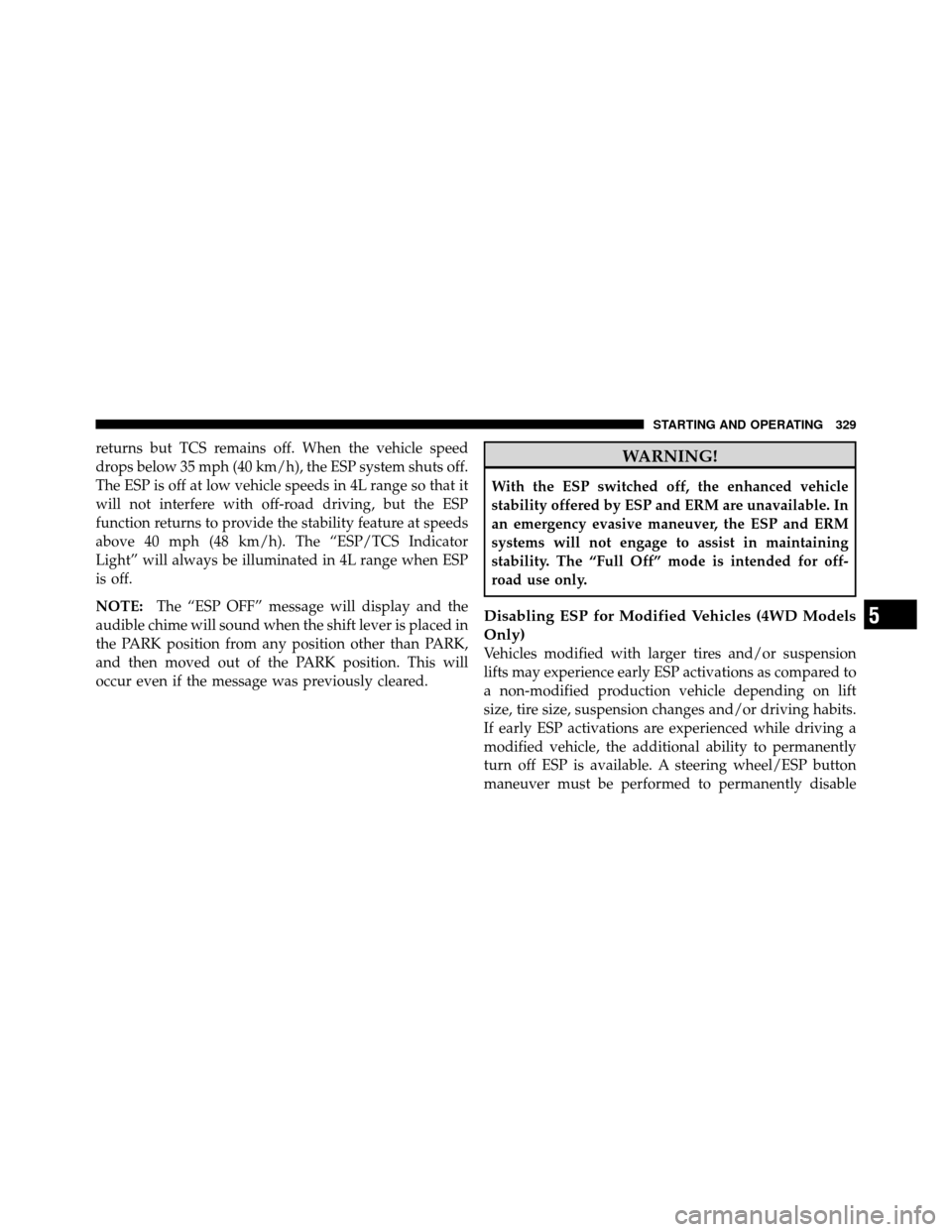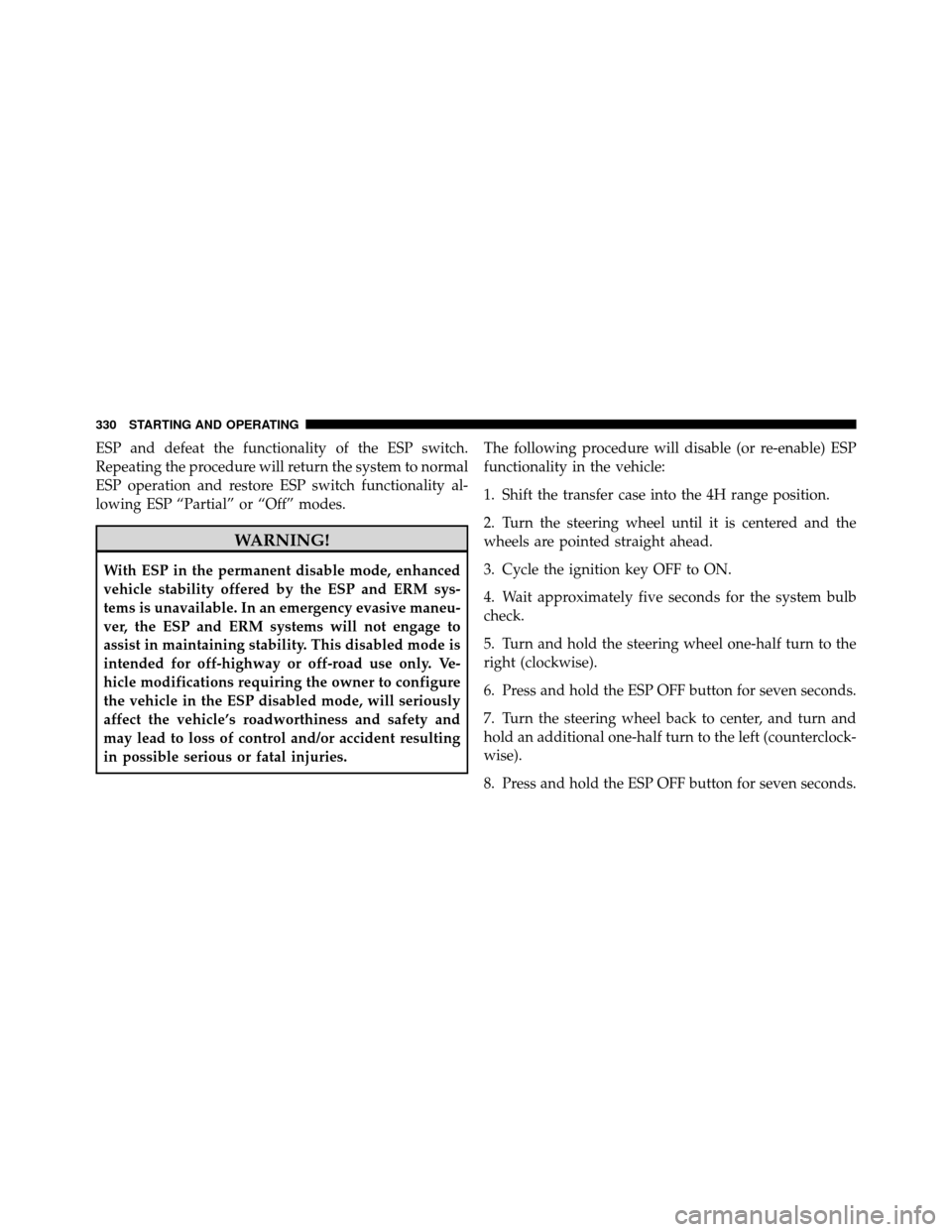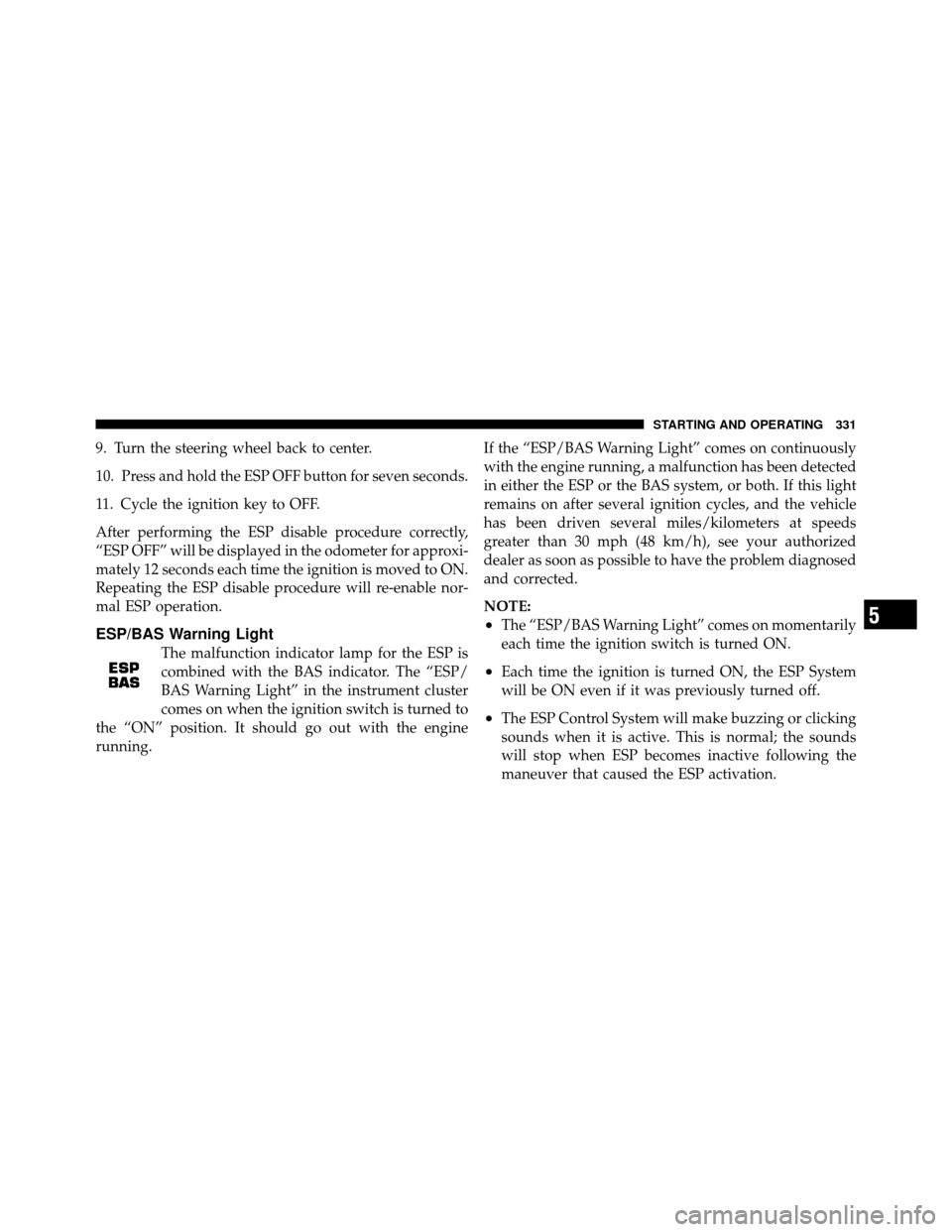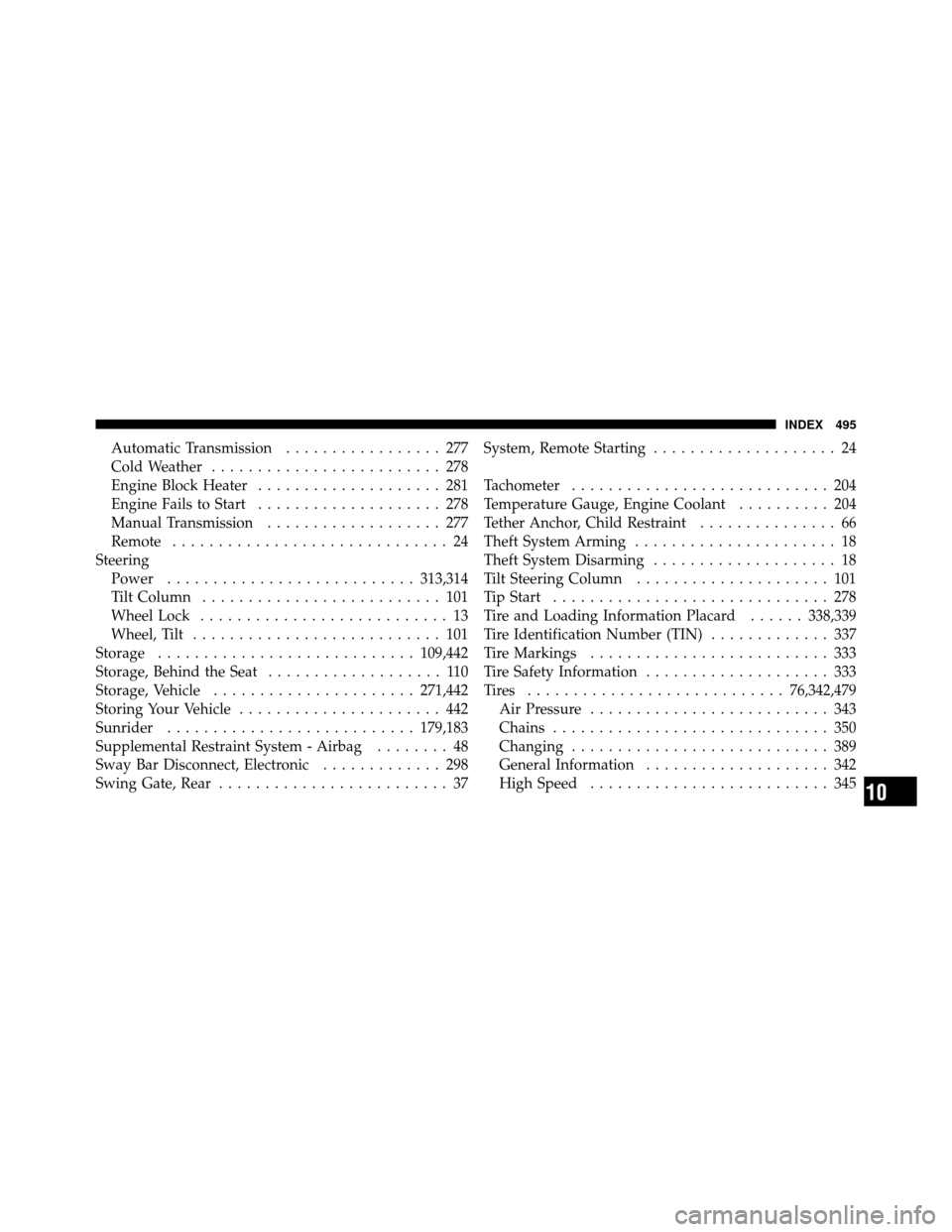steering wheel JEEP WRANGLER 2009 JK / 3.G Owner's Manual
[x] Cancel search | Manufacturer: JEEP, Model Year: 2009, Model line: WRANGLER, Model: JEEP WRANGLER 2009 JK / 3.GPages: 502, PDF Size: 14.47 MB
Page 327 of 502

WARNING!
Many factors, such as vehicle loading, road condi-
tions and driving conditions, influence the chance
that wheel lift or rollover may occur. Electronic Roll
Mitigation (ERM) cannot prevent all wheel lift or
rollovers, especially those that involve leaving the
roadway or striking objects or other vehicles. Only a
safe, attentive, and skillful driver can prevent acci-
dents. The capabilities of an ERM-equipped vehicle
must never be exploited in a reckless or dangerous
manner which could jeopardize the user’s safety or
the safety of others.
Electronic Stability Program (ESP)
This system enhances directional control and stability of
the vehicle under various driving conditions. The ESP
corrects for over/under steering of the vehicle by apply-
ing the brake of the appropriate wheel to assist incounteracting the over/under steer condition. Engine
power may also be reduced to help the vehicle maintain
the desired path.
ESP uses sensors in the vehicle to determine the vehicle
path intended by the driver and compares it to the actual
path of the vehicle. When the actual path does not match
the intended path, ESP applies the brake of the appropri-
ate wheel to assist in counteracting the oversteer or
understeer condition.
•Oversteer - when the vehicle is turning more than
appropriate for the steering wheel position.
•Understeer - when the vehicle is turning less than
appropriate for the steering wheel position.
The “ESP/TCS Indicator Light” (located in the instru-
ment cluster), starts to flash as soon as the tires lose
traction and the ESP system becomes active. The “ESP/
TCS Indicator Light” also flashes when TCS is active. If
5
STARTING AND OPERATING 325
Page 331 of 502

returns but TCS remains off. When the vehicle speed
drops below 35 mph (40 km/h), the ESP system shuts off.
The ESP is off at low vehicle speeds in 4L range so that it
will not interfere with off-road driving, but the ESP
function returns to provide the stability feature at speeds
above 40 mph (48 km/h). The “ESP/TCS Indicator
Light” will always be illuminated in 4L range when ESP
is off.
NOTE:The “ESP OFF” message will display and the
audible chime will sound when the shift lever is placed in
the PARK position from any position other than PARK,
and then moved out of the PARK position. This will
occur even if the message was previously cleared.WARNING!
With the ESP switched off, the enhanced vehicle
stability offered by ESP and ERM are unavailable. In
an emergency evasive maneuver, the ESP and ERM
systems will not engage to assist in maintaining
stability. The “Full Off” mode is intended for off-
road use only.
Disabling ESP for Modified Vehicles (4WD Models
Only)
Vehicles modified with larger tires and/or suspension
lifts may experience early ESP activations as compared to
a non-modified production vehicle depending on lift
size, tire size, suspension changes and/or driving habits.
If early ESP activations are experienced while driving a
modified vehicle, the additional ability to permanently
turn off ESP is available. A steering wheel/ESP button
maneuver must be performed to permanently disable
5
STARTING AND OPERATING 329
Page 332 of 502

ESP and defeat the functionality of the ESP switch.
Repeating the procedure will return the system to normal
ESP operation and restore ESP switch functionality al-
lowing ESP “Partial” or “Off” modes.
WARNING!
With ESP in the permanent disable mode, enhanced
vehicle stability offered by the ESP and ERM sys-
tems is unavailable. In an emergency evasive maneu-
ver, the ESP and ERM systems will not engage to
assist in maintaining stability. This disabled mode is
intended for off-highway or off-road use only. Ve-
hicle modifications requiring the owner to configure
the vehicle in the ESP disabled mode, will seriously
affect the vehicle’s roadworthiness and safety and
may lead to loss of control and/or accident resulting
in possible serious or fatal injuries.The following procedure will disable (or re-enable) ESP
functionality in the vehicle:
1. Shift the transfer case into the 4H range position.
2. Turn the steering wheel until it is centered and the
wheels are pointed straight ahead.
3. Cycle the ignition key OFF to ON.
4. Wait approximately five seconds for the system bulb
check.
5. Turn and hold the steering wheel one-half turn to the
right (clockwise).
6. Press and hold the ESP OFF button for seven seconds.
7. Turn the steering wheel back to center, and turn and
hold an additional one-half turn to the left (counterclock-
wise).
8. Press and hold the ESP OFF button for seven seconds.
330 STARTING AND OPERATING
Page 333 of 502

9. Turn the steering wheel back to center.
10. Press and hold the ESP OFF button for seven seconds.
11. Cycle the ignition key to OFF.
After performing the ESP disable procedure correctly,
“ESP OFF” will be displayed in the odometer for approxi-
mately 12 seconds each time the ignition is moved to ON.
Repeating the ESP disable procedure will re-enable nor-
mal ESP operation.
ESP/BAS Warning Light
The malfunction indicator lamp for the ESP is
combined with the BAS indicator. The “ESP/
BAS Warning Light” in the instrument cluster
comes on when the ignition switch is turned to
the “ON” position. It should go out with the engine
running. If the “ESP/BAS Warning Light” comes on continuously
with the engine running, a malfunction has been detected
in either the ESP or the BAS system, or both. If this light
remains on after several ignition cycles, and the vehicle
has been driven several miles/kilometers at speeds
greater than 30 mph (48 km/h), see your authorized
dealer as soon as possible to have the problem diagnosed
and corrected.
NOTE:
•The “ESP/BAS Warning Light” comes on momentarily
each time the ignition switch is turned ON.
•Each time the ignition is turned ON, the ESP System
will be ON even if it was previously turned off.
•The ESP Control System will make buzzing or clicking
sounds when it is active. This is normal; the sounds
will stop when ESP becomes inactive following the
maneuver that caused the ESP activation.
5
STARTING AND OPERATING 331
Page 351 of 502

WARNING!
•Do not use a tire, wheel size or rating other than
that specified for your vehicle. Some combinations
of unapproved tires and wheels may change sus-
pension dimensions and performance characteris-
tics, resulting in changes to steering, handling, and
braking of your vehicle. This can cause unpredict-
able handling and stress to steering and suspen-
sion components. You could lose control and have
an accident resulting in serious injury or death.
Use only the tire and wheel sizes with load ratings
approved for your vehicle.
•Never use a tire with a smaller load index or
capacity, other than what was originally equipped
on your vehicle. Using a tire with a smaller load
index could result in tire overloading and failure.
You could lose control and have an accident.(Continued)
WARNING! (Continued)
•Failure to equip your vehicle with tires having
adequate speed capability can result in sudden tire
failure and loss of vehicle control.
CAUTION!
Replacing original tires with tires of a different size
may result in false speedometer and odometer read-
ings.
5
STARTING AND OPERATING 349
Page 492 of 502

Exterior.............................. 76
Fog .............................. 96,445
Hazard Warning Flasher ................. 388
Headlight Switch ....................... 95
Headlights ........................... 444
High Beam .......................... 201
High Beam Indicator .................... 201
Instrument Cluster ...................... 95
Interior .............................. 97
Lights On Reminder ..................... 95
Low Fuel ............................ 200
Oil Pressure .......................... 201
Passing .............................. 96
Rear Servicing ........................ 446
Rear Tail ............................ 446
Seat Belt Reminder ..................... 201
Security Alarm (Theft Alarm) .............. 204
Service ............................. 444
Side Marker .......................... 446 Theft Alarm (Security Alarm)
.............. 204
Tire Pressure Monitoring (TPMS) ........... 206
Traction Control ....................... 211
Turn Signal ................. 76,96,201,445,446
Voltage ............................. 200
Warning (Instrument Cluster Description) ..... 200
Loading Vehicle ......................... 363
Tires ............................... 338
Locking Axle ........................ 296,297
Locks Door ................................ 30
Power Door ........................... 32
Steering Wheel ......................... 13
Lower Anchors and Tether for CHildren
(LATCH) ............................ 66,68
Lubrication, Body ....................... 411
Maintenance Free Battery .................. 409
Maintenance Procedures ................... 405
490 INDEX
Page 497 of 502

Automatic Transmission................. 277
Cold Weather ......................... 278
Engine Block Heater .................... 281
Engine Fails to Start .................... 278
Manual Transmission ................... 277
Remote .............................. 24
Steering Power ........................... 313,314
Tilt Column .......................... 101
Wheel Lock ........................... 13
Wheel, Tilt ........................... 101
Storage ............................ 109,442
Storage, Behind the Seat ................... 110
Storage, Vehicle ...................... 271,442
Storing Your Vehicle ...................... 442
Sunrider ........................... 179,183
Supplemental Restraint System - Airbag ........ 48
Sway Bar Disconnect, Electronic ............. 298
Swing Gate, Rear ......................... 37 System, Remote Starting
.................... 24
Tachometer ............................ 204
Temperature Gauge, Engine Coolant .......... 204
Tether Anchor, Child Restraint ............... 66
Theft System Arming ...................... 18
Theft System Disarming .................... 18
Tilt Steering Column ..................... 101
Tip Start .............................. 278
Tire and Loading Information Placard ......338,339
Tire Identification Number (TIN) ............. 337
Tire Markings .......................... 333
Tire Safety Information .................... 333
Tires ............................ 76,342,479
Air Pressure .......................... 343
Chains .............................. 350
Changing ............................ 389
General Information .................... 342
High Speed .......................... 345
10
INDEX 495